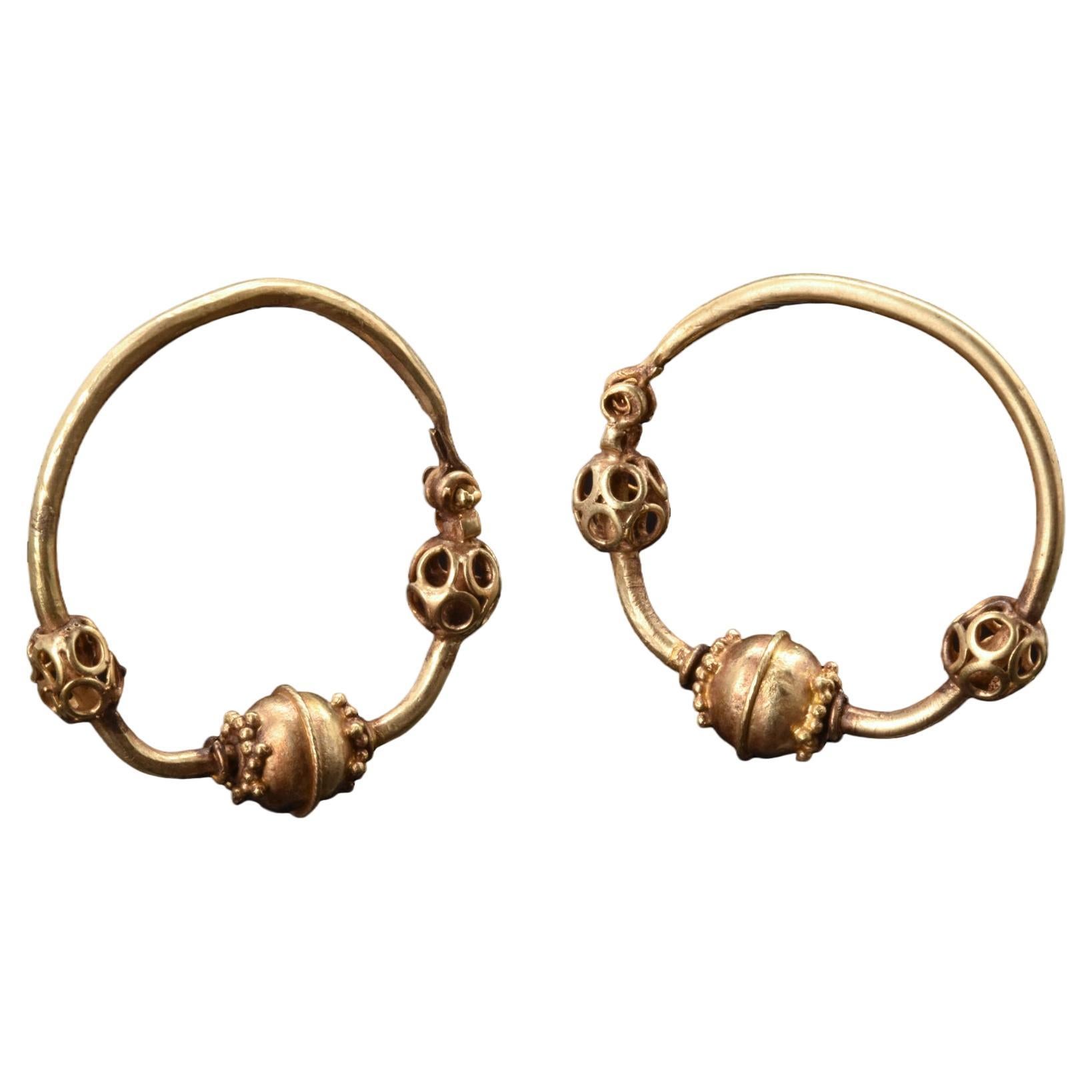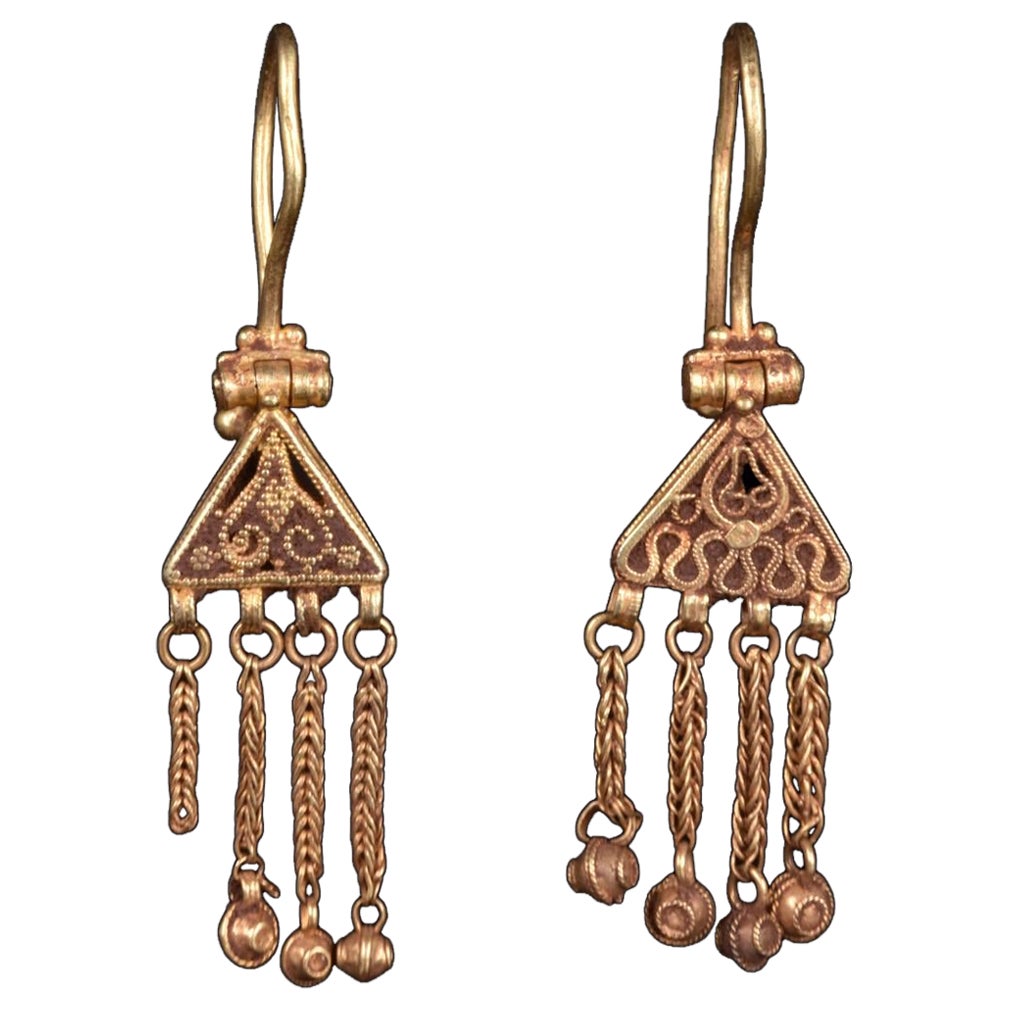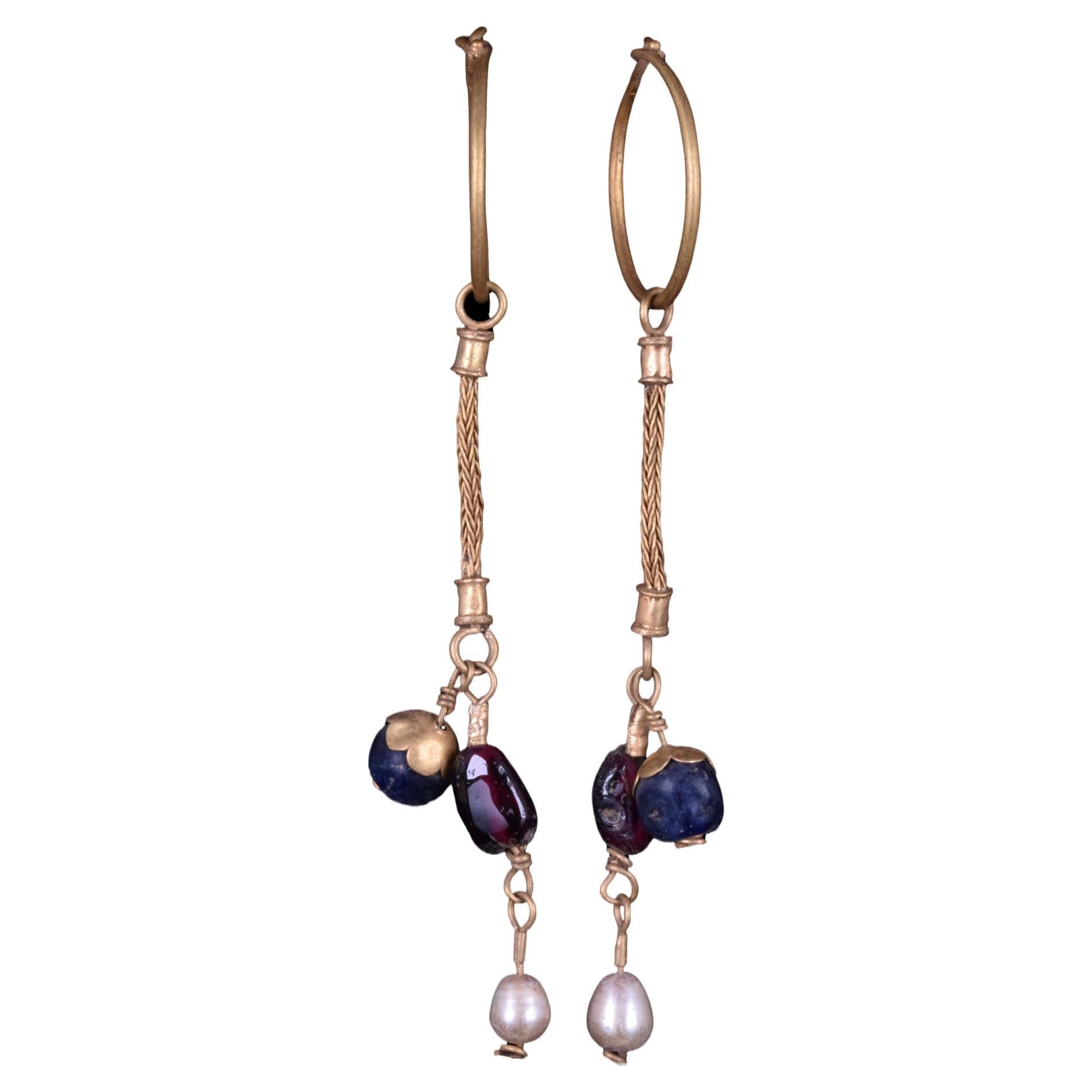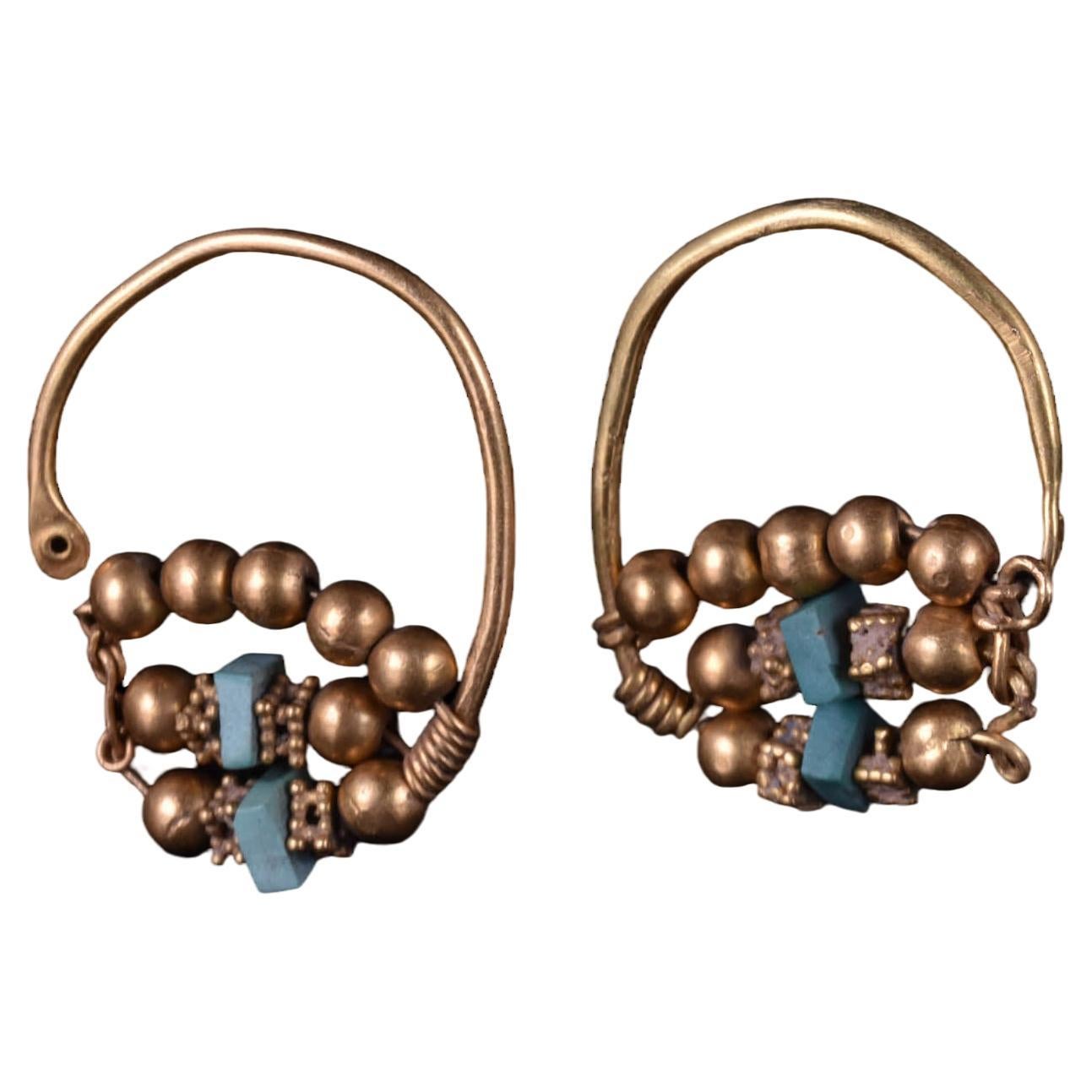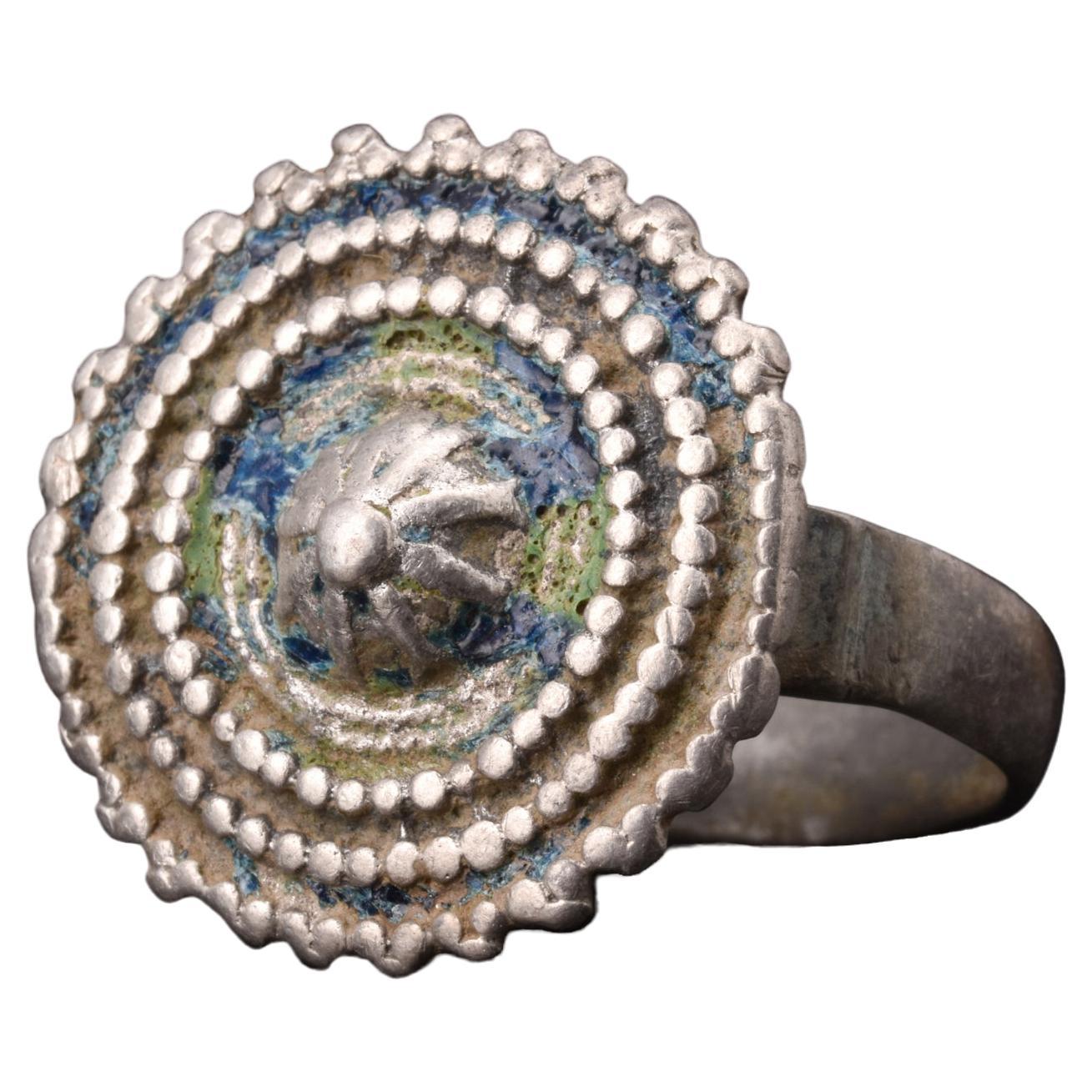Items Similar to Byzantine Pair of Electrum Earrings
Want more images or videos?
Request additional images or videos from the seller
Byzantine Pair of Electrum Earrings
About the Item
A Byzantine matching pair of electrum earrings that are crafted with utmost skill and care. Each earring features a round-section hoop with a central, biconical adornment with a hollow interior. The biconical pendants are flanked on either side by a series of coiled decorations, fashioned out of thin, stylized rope wires that seem to weave around the central motif. These decorative elements are further enhanced by a pronounced rib decoration that adds an extra dimension of texture and complexity to the overall design.
Size: L: 39.2-40.5mm / W: 36.8-38.6mm ; 8.38-11.69g
Provenance: From the collection of Surrey gentleman, formerly acquired on the UK Art Market.
(Please refer to the description for the correct size)
- Dimensions:Height: 0.4 in (1 cm)Diameter: 0.4 in (1 cm)
- Style:Medieval (Of the Period)
- Materials and Techniques:
- Period:
- Date of Manufacture:Ca. AD 500-600
- Condition:Wear consistent with age and use.
- Seller Location:London, GB
- Reference Number:
About the Seller
No Reviews Yet
Vetted Seller
These experienced sellers undergo a comprehensive evaluation by our team of in-house experts.
1stDibs seller since 2022
- ShippingRetrieving quote...Ships From: London, United Kingdom
- Return PolicyA return for this item may be initiated within 14 days of delivery.
More From This SellerView All
- Byzantine Gold Matching Pair of EarringsLocated in London, GBA matched pair of Byzantine gold hoop earrings with a hook and eye closure. These exquisite earrings have three spherical decorative elements suspended along each loop. At the centre, a ball with beading at its edges and at both sides, symmetrical attachments adorned with circular openwork decoration. The use of gold in Byzantine jewellery...Category
Antique 15th Century and Earlier Medieval Antiquities
MaterialsGold
- Byzantine Gold pair of Earrings with DanglesLocated in London, GBA stunning matched pair of Byzantine gold earrings, each comprised of a hinged and elongated hoop attached to a triangular-shaped plaque with a...Category
Antique 15th Century and Earlier Medieval Antiquities
MaterialsGold
- Byzantine Matching Pair of Gold Earrings with Pearls and Glass BeadsLocated in London, GBA matched pair of Byzantine gold earrings, each with a tapering hoop, hook-and-clasp closure, and a single elongated pendant. The pendant is co...Category
Antique 15th Century and Earlier Medieval Antiquities
MaterialsGold
- A Matched Pair of Gold EarringsLocated in London, GBA matched pair of gold earrings, each made of a wire elongated hoop culminating with a teardrop turquoise cabochon. The bottom half of the loop is decorated with three rows of gold b...Category
Antique 15th Century and Earlier Medieval Antiquities
MaterialsGold
- Massive Byzantine Bronze Reliquary Cross PendantLocated in London, GBA cast-bronze Byzantine reliquary cross pendant with two cruciform plaques that open for relic or document storage, depicting the crucified Christ on both faces. Relics, the physical...Category
Antique 15th Century and Earlier Medieval Antiquities
MaterialsBronze
- Byzantine Silver Ring with Granulated Shield BezelLocated in London, GBA silver Byzantine ring, distinguished by its large, granulated shield bezel, which reflects the artistic prowess and cultural significance of the Byzantine Empire. The ring possesse...Category
Antique 15th Century and Earlier Medieval Antiquities
MaterialsSilver
You May Also Like
- Pair of 2 Italian Obelisk 1950Located in Los Angeles, CABeautiful pair of two Italian obelisk made in Italy in 1950s.Category
Vintage 1950s European Mid-Century Modern Antiquities
MaterialsChrome
- Pair of Antiques Money / Bank, ElephantsLocated in Mexico City, CDMXPair of Antiques money box / bank, elephants. One of them circa 1920, made in iron, the other circa 1960 made in aluminium.Category
Vintage 1940s American Industrial Antiquities
MaterialsAluminum, Iron
- Ancient Pair of Carved Wooden Sculptures of Horses, 19th CenturyLocated in Cuneo, Italy (CN)Ancient pair of carved hardwood sculptures, depicting a pair of trotting horses, sculpted in the 19th century. They measure about W 7 x H 30 x T 30 cm.Category
Antique Early 19th Century European Animal Sculptures
MaterialsWood
- Antique Gothic Carved Limestone Model of a Madonna or VenusLocated in Philadelphia, PAA fine antique limestone carving. Modeled as a Madonna. With her head slightly tilted, holding an orb in one hand, and with her other hand resting on her breast. By repute ...Category
Antique 15th Century and Earlier Unknown Gothic Figurative Sculptures
MaterialsLimestone
- Pair Of Antique Boule Balls "4", Pétanque, 1880s, France, CraftsmanshipLocated in Greven, DEBeautiful, unique Boule ball pair, France, late 19th Century. Diameter 9,4 cm. In the 19th century, the manufacture of boules balls underwent significant development in France as th...Category
Antique Late 19th Century French Late Victorian Antiquities
MaterialsOlive
- Pair Of Antique Boule Balls, Pétanque, 1880s, France, CraftsmanshipLocated in Greven, DEBeautiful, unique Boule ball pair, France, late 19th Century. Diameter 9,5 cm. In the 19th century, the manufacture of boules balls underwent significant development in France as the game of boules, particularly the pétanque variant, gained in popularity. The manufacture of boules balls during this period was a manual process that required expertise, precision and love to detail. In the late 19th and early 20th centuries, particularly in rural areas of France and other Mediterranean regions, olive wood was a commonly used source of material for making boules balls. This was not only due to the availability of the material, but also to the outstanding properties of olive wood, which was characterized by hardness, strength and a rich grain. First, the olive wood was carefully selected and shaped into raw balls, which were then sanded to the desired size and shape. The nails were then hammered into the balls one by one, making sure that they were evenly distributed and firmly anchored. Finally, the spheres were polished and coated with a protective varnish to enhance their natural beauty and protect them from the elements. The use of nails to decorate and reinforce olive wood boules was a traditional practice that not only gave the ball a rustic aesthetic, but also improved its durability and contributed to customization. Many balls were made according to the specific requirements and preferences of the players. Nails were driven at regular intervals around the ball, with each nail hole precisely placed so as not to affect the balance and weight distribution of the ball. These nails not only served as a decorative element, but also helped to strengthen the structure of the ball and make it more resistant to the hard knocks and wear and tear during play. Individual engravings or decorations were often applied to the balls to make them unique and identify the player. Antique boules...Category
Antique Late 19th Century French Late Victorian Antiquities
MaterialsOlive
Recently Viewed
View AllMore Ways To Browse
Coral Top Console
Dresden Porcelain Birds
Dropped Arm Sofa
Emerald Green Ashtray
Mcm Black Leather Chair
Pie Crust Tea
Porcelain Painting Plaque Chinese
Whisky Sterling
Baccarat Liqueur Glasses
English Oak Antique Carved Dining Chairs
Olive Accent Chairs
Poker Dice Game
Woodland Indian
Woven Rush Armchairs Pair
Cherubs Wall Decor
Chinese Carved Horseshoe Chair
La Fontana Floor Lamp
White Pagoda Lamp
